2004 ISUZU TF SERIES oil pressure
[x] Cancel search: oil pressurePage 1937 of 4264

ENGINE COOLING (6VE1 3.5L) 6B-13
6. Connect oil cooler hose to automatic transmission.
RTW36BSH000101
7. Connect battery ground cable.
8. Pour engine coolant up to filler neck of radiator, and
up to MAX mark of reserve tank.
RTW36BSH000101
Important operation (in case of 100% engine
coolant change) procedure for filling with engine
coolant.
Engine coolant change
1. To change engine coolant, make sure that the
engine is cool.
WARNING: When the coolant is heated to a high
temperature, be sure not to loosen or remove the
radiator cap. Otherwise you might get scalded by
hot vapor or boiling water. To open the radiato
r
cap, put a piece of thick cloth on the cap and
loosen the cap slowly to reduce the pressure when
the coolant has become cooler.
2. Open radiator cap and drain the cooling system by
loosening the drain valve on the radiator and on the
cylinder body.
NOTE: For best result it is suggested that the engine
cooling system be flushed at least once a year. It is
advisable to flash the interior of the cooling system
including the radiator before using anti-freeze
(ethylene-glycol based).
Replace damaged rubber hoses as the engine
anti-freeze coolant is liable to leak out even mino
r
cracks.
Isuzu recommends to use Isuzu genuine anti-freeze
(ethylen-glycol based) or equivalent, for the cooling
system and not add any inhibitors or additives.
CAUTION: A failure to correctly fill the engine
cooling system in changing or topping up coolant
may sometimes cause the coolant to overflow from
the filler neck even before the engine and radiato
r
are completely full.
If the engine runs under this condition, shortage o
f
coolant may possibly result in engine overheating.
To avoid such trouble, the following precautions
should be taken in filling the system.
3. To refill engine coolant, pour coolant up to filler neck
using a filling hose which is smaller in outside
diameter of the filler neck. Otherwise air between
the filler neck and the filling hose will block entry,
preventing the system from completely filling up.
4. Keep a filling rate of 9 liter/min. or less. Filling ove
r
this maximum rate may force air inside the engine
and radiator.
And also, the coolant overflow will increase, making
it difficult to determine whether or not the system is
completely full.
5.
After filling the system to the full, pull out the filling
hose and check to see if air trapped in the system is
disclodged and the coolant level goes down. Should
the coolant level go down, repeat topping-up until
there is no more drop in the coolant level.
Page 1938 of 4264
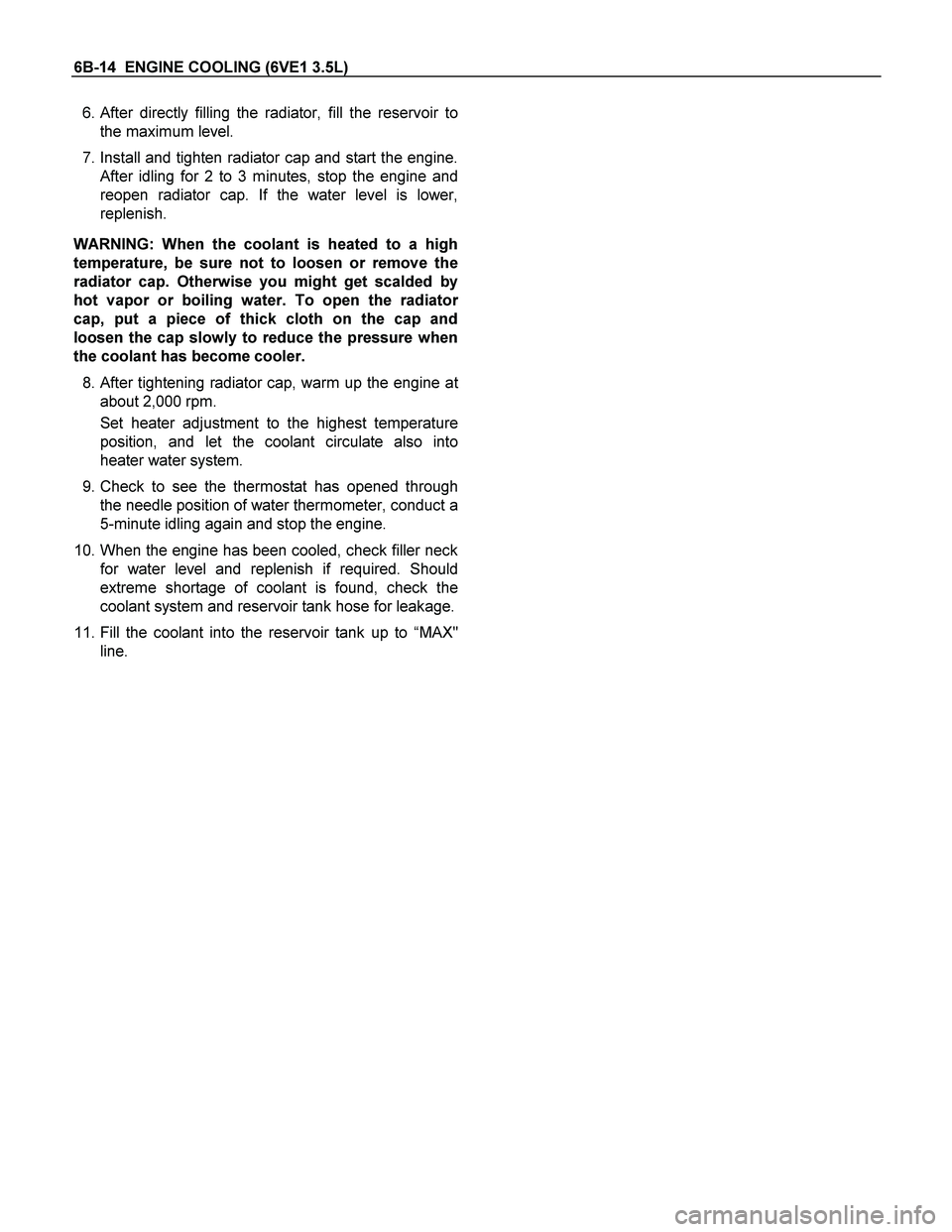
6B-14 ENGINE COOLING (6VE1 3.5L)
6. After directly filling the radiator, fill the reservoir to
the maximum level.
7. Install and tighten radiator cap and start the engine.
After idling for 2 to 3 minutes, stop the engine and
reopen radiator cap. If the water level is lower,
replenish.
WARNING: When the coolant is heated to a high
temperature, be sure not to loosen or remove the
radiator cap. Otherwise you might get scalded by
hot vapor or boiling water. To open the radiato
r
cap, put a piece of thick cloth on the cap and
loosen the cap slowly to reduce the pressure when
the coolant has become cooler.
8.
After tightening radiator cap, warm up the engine at
about 2,000 rpm.
Set heater adjustment to the highest temperature
position, and let the coolant circulate also into
heater water system.
9. Check to see the thermostat has opened through
the needle position of water thermometer, conduct a
5-minute idling again and stop the engine.
10. When the engine has been cooled, check filler neck
for water level and replenish if required. Should
extreme shortage of coolant is found, check the
coolant system and reservoir tank hose for leakage.
11. Fill the coolant into the reservoir tank up to “MAX"
line.
Page 1943 of 4264
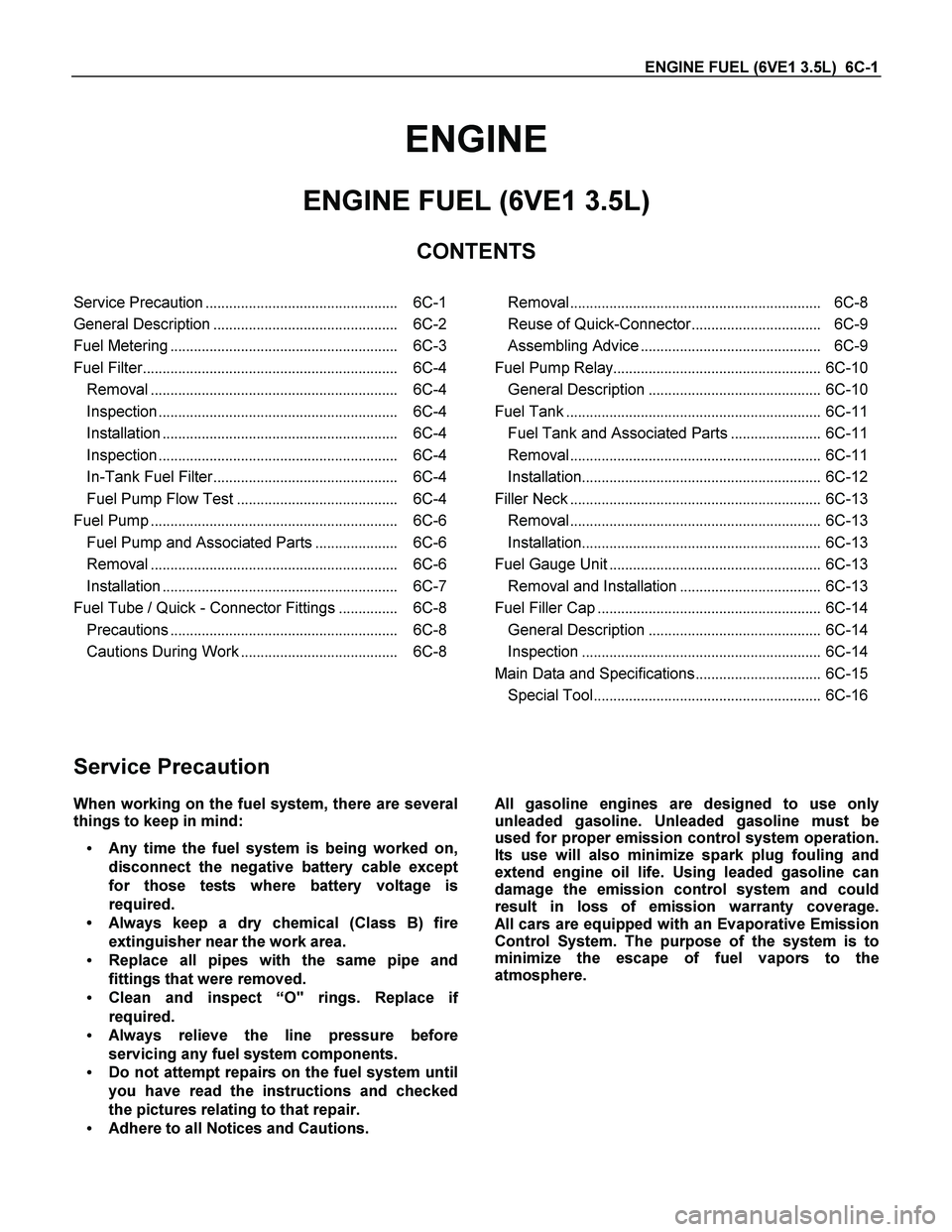
ENGINE FUEL (6VE1 3.5L) 6C-1
ENGINE
ENGINE FUEL (6VE1 3.5L)
CONTENTS
Service Precaution................................................. 6C-1
General Description............................................... 6C-2
Fuel Metering.......................................................... 6C-3
Fuel Filter................................................................. 6C-4
Removal............................................................... 6C-4
Inspection............................................................. 6C-4
Installation............................................................ 6C-4
Inspection............................................................. 6C-4
In-Tank Fuel Filter............................................... 6C-4
Fuel Pump Flow Test......................................... 6C-4
Fuel Pump............................................................... 6C-6
Fuel Pump and Associated Parts..................... 6C-6
Removal............................................................... 6C-6
Installation............................................................ 6C-7
Fuel Tube / Quick - Connector Fittings............... 6C-8
Precautions.......................................................... 6C-8
Cautions During Work........................................ 6C-8
Removal................................................................ 6C-8
Reuse of Quick-Connector................................. 6C-9
Assembling Advice.............................................. 6C-9
Fuel Pump Relay..................................................... 6C-10
General Description............................................ 6C-10
Fuel Tank................................................................. 6C-11
Fuel Tank and Associated Parts....................... 6C-11
Removal................................................................ 6C-11
Installation............................................................. 6C-12
Filler Neck................................................................ 6C-13
Removal................................................................ 6C-13
Installation............................................................. 6C-13
Fuel Gauge Unit...................................................... 6C-13
Removal and Installation.................................... 6C-13
Fuel Filler Cap......................................................... 6C-14
General Description............................................ 6C-14
Inspection............................................................. 6C-14
Main Data and Specifications................................ 6C-15
Special Tool.......................................................... 6C-16
Service Precaution
When working on the fuel system, there are several
things to keep in mind:
Any time the fuel system is being worked on,
disconnect the negative battery cable except
for those tests where battery voltage is
required.
Always keep a dry chemical (Class B) fire
extinguisher near the work area.
Replace all pipes with the same pipe and
fittings that were removed.
Clean and inspect “O" rings. Replace i
f
required.
Always relieve the line pressure before
servicing any fuel system components.
Do not attempt repairs on the fuel system until
you have read the instructions and checked
the pictures relating to that repair.
Adhere to all Notices and Cautions.
All gasoline engines are designed to use only
unleaded gasoline. Unleaded gasoline must be
used for proper emission control system operation.
Its use will also minimize spark plug fouling and
extend engine oil life. Using leaded gasoline can
damage the emission control system and could
result in loss of emission warranty coverage.
All cars are equipped with an Evaporative Emission
Control System. The purpose of the system is to
minimize the escape of fuel vapors to the
atmosphere.
Page 1950 of 4264
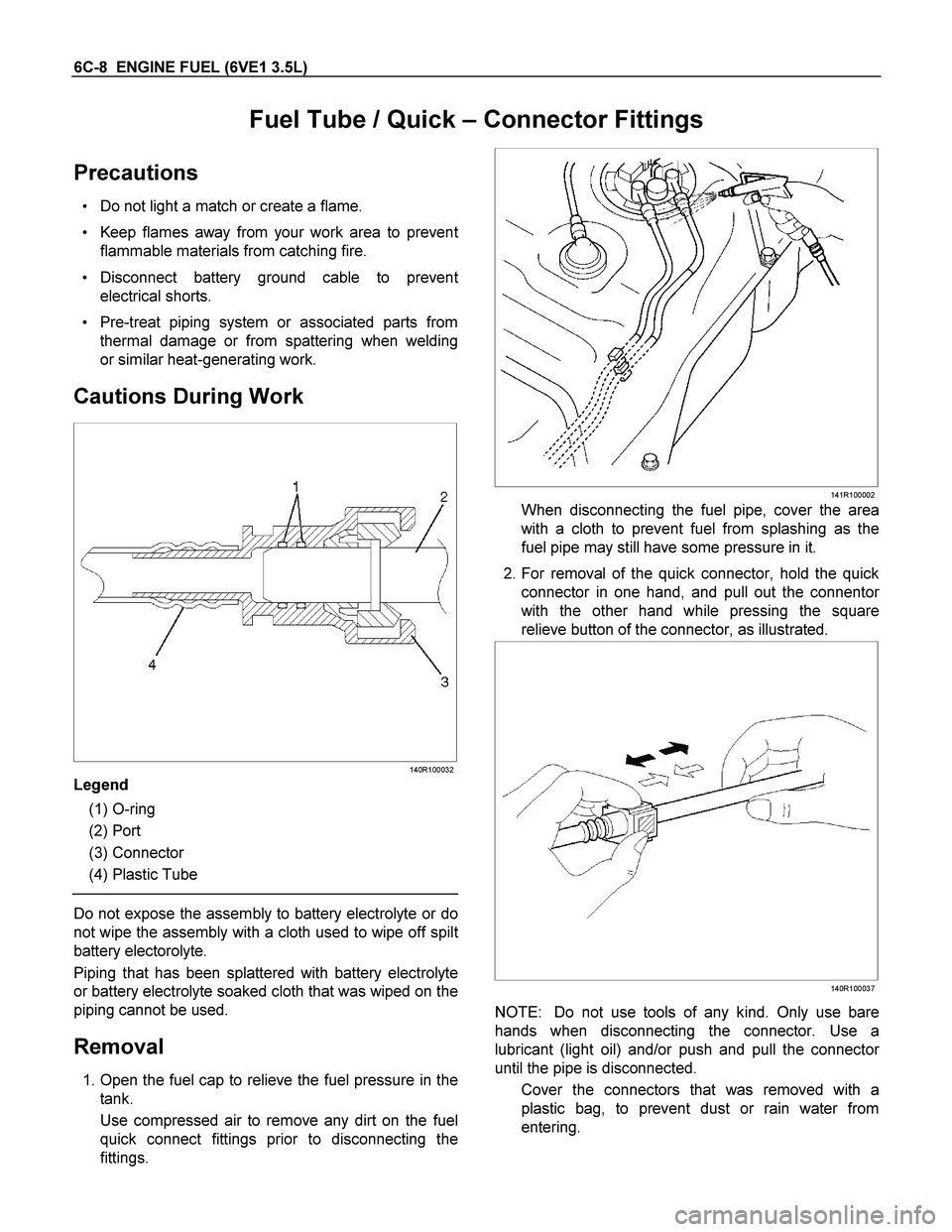
6C-8 ENGINE FUEL (6VE1 3.5L)
Fuel Tube / Quick – Connector Fittings
Precautions
Do not light a match or create a flame.
Keep flames away from your work area to preven
t
flammable materials from catching fire.
Disconnect battery ground cable to preven
t
electrical shorts.
Pre-treat piping system or associated parts from
thermal damage or from spattering when welding
or similar heat-generating work.
Cautions During Work
140R100032
Legend
(1) O-ring
(2) Port
(3) Connector
(4) Plastic Tube
Do not expose the assembly to battery electrolyte or do
not wipe the assembly with a cloth used to wipe off spil
t
battery electorolyte.
Piping that has been splattered with battery electrolyte
or battery electrolyte soaked cloth that was wiped on the
piping cannot be used.
Removal
1. Open the fuel cap to relieve the fuel pressure in the
tank.
Use compressed air to remove any dirt on the fuel
quick connect fittings prior to disconnecting the
fittings.
141R100002
When disconnecting the fuel pipe, cover the area
with a cloth to prevent fuel from splashing as the
fuel pipe may still have some pressure in it.
2. For removal of the quick connector, hold the quick
connector in one hand, and pull out the connento
r
with the other hand while pressing the square
relieve button of the connector, as illustrated.
140R100037
NOTE: Do not use tools of any kind. Only use bare
hands when disconnecting the connector. Use a
lubricant (light oil) and/or push and pull the connecto
r
until the pipe is disconnected.
Cover the connectors that was removed with a
plastic bag, to prevent dust or rain water from
entering.
Page 1951 of 4264
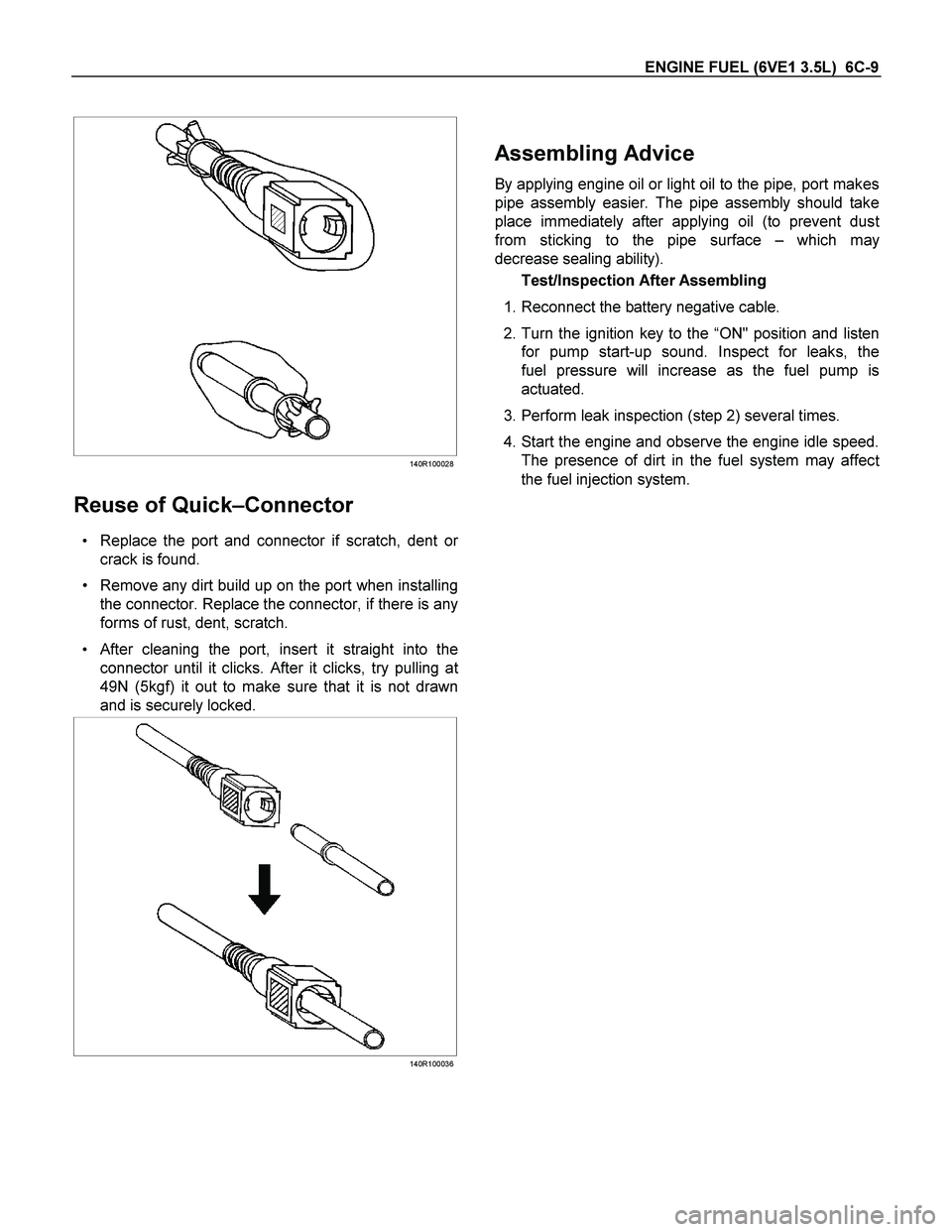
ENGINE FUEL (6VE1 3.5L) 6C-9
140R100028
Reuse of Quick–Connector
Replace the port and connector if scratch, dent or
crack is found.
Remove any dirt build up on the port when installing
the connector. Replace the connector, if there is any
forms of rust, dent, scratch.
After cleaning the port, insert it straight into the
connector until it clicks. After it clicks, try pulling a
t
49N (5kgf) it out to make sure that it is not drawn
and is securely locked.
140R100036
Assembling Advice
By applying engine oil or light oil to the pipe, port makes
pipe assembly easier. The pipe assembly should take
place immediately after applying oil (to prevent dus
t
from sticking to the pipe surface –which may
decrease sealing ability).
Test/Inspection After Assembling
1. Reconnect the battery negative cable.
2. Turn the ignition key to the “ON" position and listen
for pump start-up sound. Inspect for leaks, the
fuel pressure will increase as the fuel pump is
actuated.
3. Perform leak inspection (step 2) several times.
4. Start the engine and observe the engine idle speed.
The presence of dirt in the fuel system may affec
t
the fuel injection system.
Page 2000 of 4264
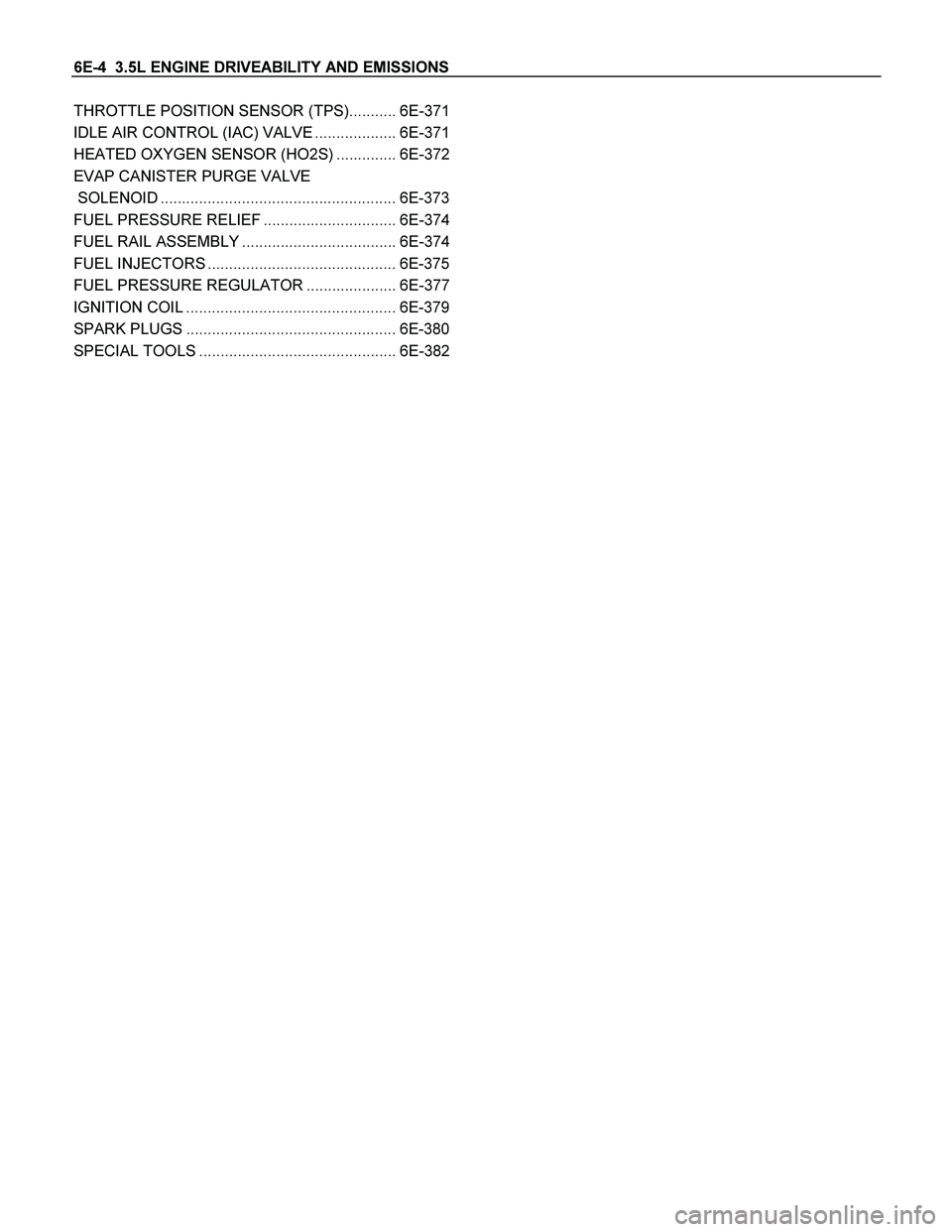
6E-4 3.5L ENGINE DRIVEABILITY AND EMISSIONS
THROTTLE POSITION SENSOR (TPS)........... 6E-371
IDLE AIR CONTROL (IAC) VALVE ................... 6E-371
HEATED OXYGEN SENSOR (HO2S) .............. 6E-372
EVAP CANISTER PURGE VALVE
SOLENOID ....................................................... 6E-373
FUEL PRESSURE RELIEF ............................... 6E-374
FUEL RAIL ASSEMBLY .................................... 6E-374
FUEL INJECTORS ............................................ 6E-375
FUEL PRESSURE REGULATOR ..................... 6E-377
IGNITION COIL ................................................. 6E-379
SPARK PLUGS ................................................. 6E-380
SPECIAL TOOLS .............................................. 6E-382
Page 2023 of 4264
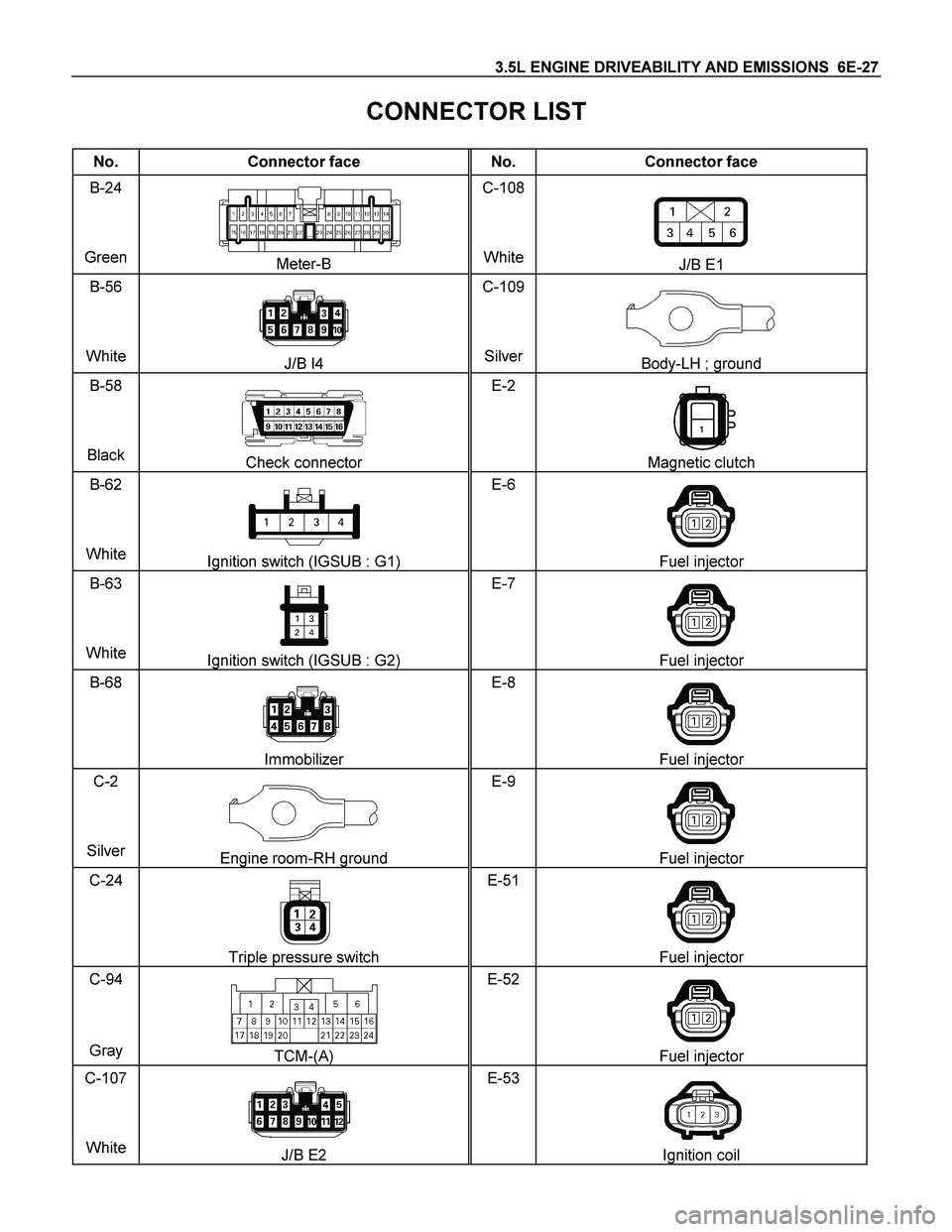
3.5L ENGINE DRIVEABILITY AND EMISSIONS 6E-27
CONNECTOR LIST
No. Connector face No. Connector face
B-24
Green
Meter-B C-108
WhiteJ/B E1
B-56
White
J/B I4 C-109
SilverBody-LH ; ground
B-58
Black
Check connector E-2
Magnetic clutch
B-62
White
Ignition switch (IGSUB : G1) E-6
Fuel injector
B-63
White
Ignition switch (IGSUB : G2) E-7
Fuel injector
B-68
Immobilizer E-8
Fuel injector
C-2
Silver
Engine room-RH ground E-9
Fuel injector
C-24
Triple pressure switch E-51
Fuel injector
C-94
Gray TCM-(A) E-52
Fuel injector
C-107
White
J/B E2 E-53
Ignition coil
Page 2024 of 4264

6E-28 3.5L ENGINE DRIVEABILITY AND EMISSIONS
No. Connector face No. Connector face
E-54
Ignition coil E-64
Oil pressure switch (P/STRG)
E-55
Ignition coil E-66
Duty solenoid
E-56
Ignition coil E-68
Throttle position sensor
E-57
Ignition coil E-69
Temperature sensor
E-58
Ignition coil E-70
IACV
E-59
Crank position sensor E-72
Engine earth-A
E-60
ECM-A E-73
Engine earth-A
E-61
ECM-B E-74
Engine earth-B
E-62
Cam position sensor E-76
EGR valve
E-63
MAF sensor E-77
O2 sensor RH-Front